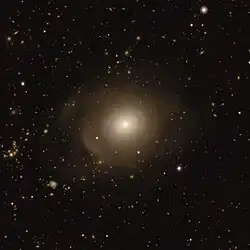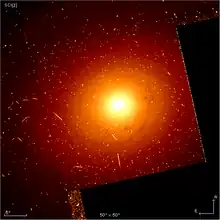| NGC 788 | |
|---|---|
 NGC 788 as seen by legacy surveys | |
| Observation data (J2000 epoch) | |
| Constellation | Cetus |
| Right ascension | 02h 01m 06.46s |
| Declination | −06° 48′ 57.15″ |
| Redshift | 0.013603±0.000093 |
| Heliocentric radial velocity | 4078±28 km/s[1] |
| Apparent magnitude (V) | 12.76 |
| Characteristics | |
| Type | S0 |
| Other designations | |
| PGC 7656 | |
NGC 788 is a lenticular galaxy located in the constellation Cetus.[2] It was discovered in a sky survey by Wilhelm Herschel on September 10, 1785. Studies of NGC 788 indicate that it, while itself being classified as a Seyfert 2, contains an obscured Seyfert 1 nucleus, following the detection of a broad Hα emission line in the polarized flux spectrum. The observation also indicated the lowest radio luminosities observed in an obscured Seyfert 1.[3]
One supernova has been observed in NGC 788: SN 1998dj (type Ia, mag. 16).[4]

Hubble WFPC2 image of the center of NGC 788
References
- ↑ "Detailed Information for a Named Object: NGC 788". Retrieved January 23, 2022.
- ↑ "NGC 788". Retrieved January 23, 2022.
- ↑ "A Hidden Broad-Line Region in the Weak Seyfert 2 Galaxy NGC 788" (PDF). Archived from the original (PDF) on September 7, 2021. Retrieved January 23, 2022.
- ↑ Transient Name Server entry for SN 1998dj. Retrieved 30 March 2023.
This article is issued from Wikipedia. The text is licensed under Creative Commons - Attribution - Sharealike. Additional terms may apply for the media files.